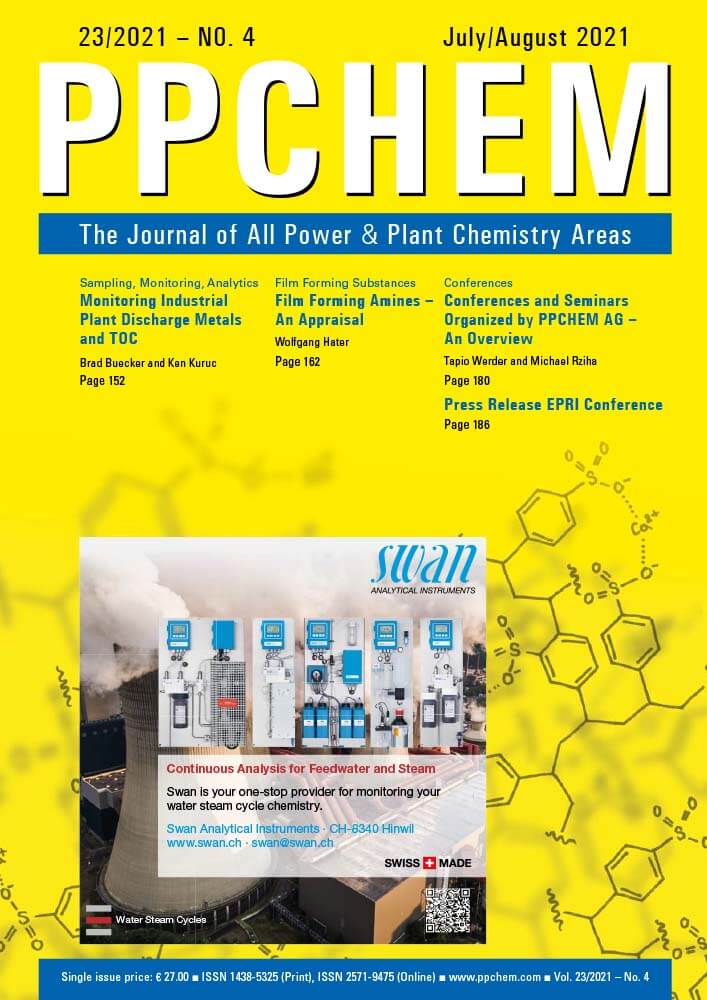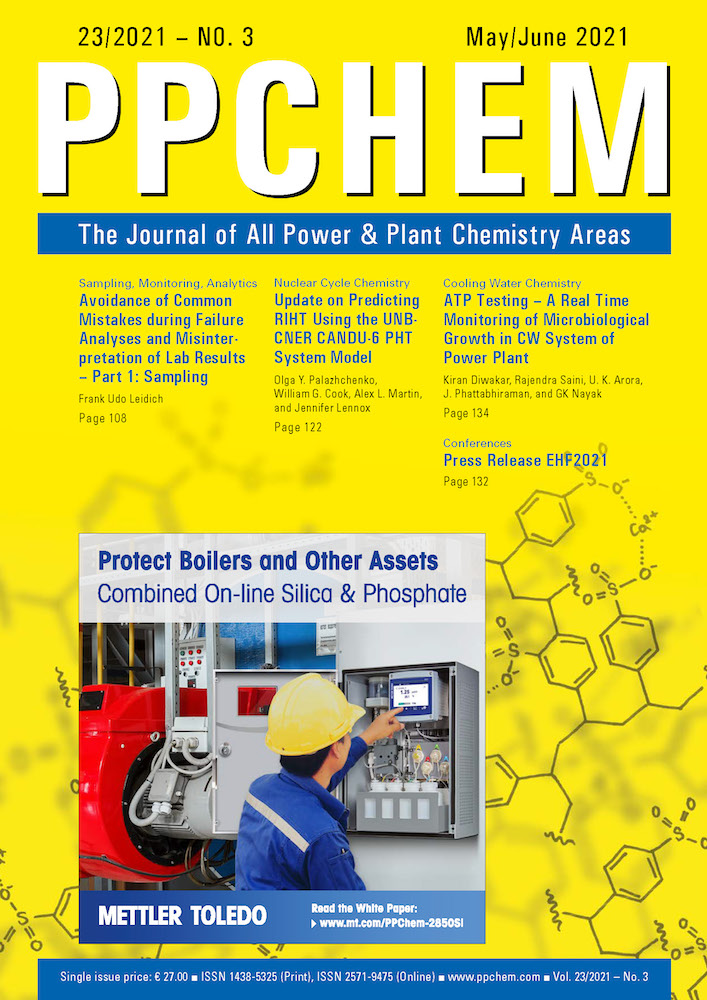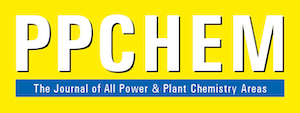Author: anderthalbAdmin
E-Paper – Issue 05 (2021)
Article – Issue 04 (2021) – Film Forming Amines – An Appraisal
Article – Issue 04 (2021) – Conferences and Seminars Organized by PPCHEM AG – An Overview
Download the Article’s PDF.
Article – Issue 04 (2021) – Press Release EPRI Conference
Download the Article’s PDF.
Issue 04 (2021)

For members only
ABSTRACTS
Monitoring Industrial Plant Discharge Metals and TOC
Brad Buecker and Ken Kuruc
Industrial facilities such as refineries, petrochemical plants, steel mills, metal finishing facilities, pulp and paper mills, pharmaceutical plants, etc. require substantial wastewater treatment, as some processes at these facilities can release many complex carbon compounds or other toxic constituents, including metals, to waste streams.
While various techniques are available for measuring trace level metals in process water, to date they have been rather unavailable to many industrial locations because of capital cost requirements or the need for specially trained technicians. Two well-known techniques are inductively-coupled plasma and atomic absorption spectroscopy, which need specially trained operators and require complex sample preparation and expensive instrumentation.
This article discusses another existing technology, colorimetry, which has been modified for on-line monitoring. The method is suitable for many facilities and can be operated by a wide range of plant personnel. In many cases, the readings can be enhanced with TOC analyses to provide additional protection for industrial water/steam systems.
PPCHEM® 2021, 23(4), 152–157
For Members only
Film Forming Amines – An Appraisal
Wolfgang Hater
The technology of film forming amines or more generally film forming substances in water treatment has been well known for decades. The acceptance of their application in watersteam cycles was significantly increased by two IAPWS Technical Guidance Documents issued in 2016 and 2019. These documents provide a brief synopsis of the scientific knowhow, and, more importantly, give practical guidance to people interested in this technology. This paper reviews and summarizes the scientific progress since then and identifies further research needs. Film forming substances have an important potential for the reduction of plant emissions, which, in addition to the demand for molecules with improved environmental properties, is looked upon as a driving force for future development.
PPCHEM® 2021, 23(4), 162–175
For Members only
Conferences and Seminars Organized by PPCHEM AG – An Overview
Tapio Werder and Michael Rziha
Since 2012, PPCHEM AG and its precursor organization, Waesseri GmbH, have organized more than 30 conferences and seminars around the world with the mission of expanding the knowledge of cycle chemistry and the understanding of analytical instruments. Over the past 9 years, different formats of events have been developed to fit the different needs and interests within the power plant chemistry community.
The first kind of event series developed was called Power Cycle Instrumentation Seminars (PCIS), with the mission of expanding the knowledge of cycle chemistry and the understanding of sampling techniques and analytical instruments. Based on the feedback from the PCIS participants a new series of events – PowerPlant Chemistry Forums (PPCF) – was introduced in 2016. Compared to the PCIS the PPCF does not concentrate exclusively on sampling and instrumentation, but instead includes a wide variety of nearly all aspects of power plant chemistry, such as life-cycle chemistry optimization, start-up chemistry and early operation experience, and plant failures and subsequent chemistry adjustments. The forum is basically a typical conference, where numerous international speakers from many different organizations present, hence it is a platform for all participants to exchange information and knowledge and for networking.
Beside the PCIS and the PPCF, educational seminars have also been developed and offered. These seminars are typically focused on a “hot topic” from power plant chemistry and usually they are conducted by PPCHEM’s chief key expert power plant chemistry Michael Rziha.
This contribution outlines the developments in the past years and gives more details on the different formats of events which are currently organized by PPCHEM AG.
PPCHEM® 2021, 23(4), 180–185
For Members only
PRESS RELEASE: EPRI 13th International Conference on Cycle Chemistry in Fossil and Combined Cycle HRSG Plants (ICCC13): Details Advances in R&D
EPRI’s 13th International Conference on Cycle Chemistry in Fossil and Combined Cycle HRSG Plants was conducted virtually June 22–24, 2021.
The conference was attended by 146 different professionals representing 10 countries, including Australia, Canada, Malaysia, Philippines, Taiwan, South Africa, Switzerland, United Kingdom, United Arab Emirates, and the United States.
The EPRI Boiler and Turbine Steam and Cycle Chemistry R&D program (Program 226) conducts collaborative research led by Program Manager Brad Burns. The collaborative program is a global leader in comprehensive research in power plant steam and water cycle treatment to minimize corrosion and deposition.
The conference is hosted by EPRI every three years. This latest event featured 21 presentations by international experts, equipment manufacturers, chemical suppliers, and power plant chemistry users. Discussions on a wide range of cycle chemistry-related topics added participation value to plant users, equipment and chemical suppliers, and researchers.
PPCHEM® 2021, 23(4), 186–187
Article – Issue 04 (2021) – Monitoring Industrial Plant Discharge Metals and TOC
E-Paper – Issue 04 (2021)
Issue 03 (2021)

For members only
ABSTRACTS
Avoidance of Common Mistakes during Failure Analyses and Misinterpretation of Lab Results – Part 1: Sampling
Frank Udo Leidich
For a proper failure analysis or root cause analysis (RCA) a great deal of data and evidence-based information is needed. Within this context, various types of samples from different locations need to be taken for chemical and/or metallurgical examination. Therefore, proper and correct sampling, without alteration of the composition or contamination of the samples, is of utmost importance. Unfortunately, this is often not practiced correctly and so the risk of incorrect conclusions is high. This article is intended to help personnel obtain these samples in a proper manner and avoid common and repeated mistakes.
PPCHEM® 2021, 23(3), 108–119
For Members only
Update on Predicting RIHT Using the UNB-CNER CANDU-6 PHT System Model
Olga Y. Palazhchenko, William G. Cook, Alex L. Martin, and Jennifer Lennox
Reduced heat transfer in CANDU steam generators has safety consequences such as lower margins to fuel dryout due to higher reactor inlet header temperature (RIHT). To identify methods to maintain the RIHT within operational margins, it is necessary to model the effect of thermal degradation mechanisms on boiler heat transfer.
A comprehensive steam generator heat transfer and fouling add-on has been developed at the University of New Brunswick, Canada, and previously benchmarked using historic data from Point Lepreau Nuclear Generation Station. The one-dimensional, steady-state heat transfer code mechanistically predicts the effect of primary-side fouling, and semi-empirically models the effects of divider plate leakage and secondary-side fouling. This paper presents the most recent predictive modelling, where simulations of post-refurbishment operation (2012–2042) were conducted based on the benchmarked mechanisms. The predictive simulations inform the timeline for mitigating strategies such as a primary-side clean during the plant’s operating lifetime.
PPCHEM® 2021, 23(3), 122–131
For Members only
IAPWS Seventh Meeting of the European HRSG Forum (EHF2021)
Highlights and Press Release
Barry Dooley and Bob Anderson
The seventh annual IAPWS European HRSG Forum was held on the 18th and 20th May 2021 as a virtual event. It was chaired by Barry Dooley of Structural Integrity and Bob Anderson of Competitive Power Resources. EHF2021 attracted 90 participants from 17 countries and included 55 users.
EHF is supported by the International Association for the Properties of Water and Steam (IAPWS) and is held in association with the Australasian Boiler and HRSG Users Group
(ABHUG) and the US HRSG Forum (HF). The 2021 EHF had two sponsors: Trace Analysis and Swan Analytical Instruments. The conference was organized by PPCHEM AG.
PPCHEM® 2021, 23(3), 132–133
ATP Testing – A Real Time Monitoring of Microbiological Growth in the Cooling Water Systems of Power Plants
Kiran Diwakar, Rajendra K. Saini, Upain Kumar Arora, Janakiraman Pattabhiraman, and Gopi Kanta Nayak
In power plants, the warm environment of recirculating cooling systems is ideal for the growth of microorganisms. As microorganism communities grow in cooling systems, they can attach to tubes, pipe walls, and cooling tower fills, and form biofilms. Uncontrollable biological growth causes fouling, loss of heat exchange capacity, equipment failure, and energy wastage.
Due to the large volume of a cooling system with a flow rate of 60000–75000m3·h–1 (500 MW plus unit) and the diverse types of bacteria, spores, and algae, no one chemical can kill everything. There must be proper selection of a biocide, adequate contact time, and real time monitoring techniques to allow control of biological problems.
The best solution for any system is the fast and early detection of biological contamination, and the setting up of proactive actions and subsequent corrective treatments. For the measurement of microbiological counts, we can use culture tests like the heterotrophic plate count (HPC) method. However, these culture tests only measure culturable organisms while adenosine triphosphate (ATP) testing measures all microorganisms within a sample. There are two types of ATP – intracellular ATP contained within living biological cells and extracellular ATP located outside of biological cells, which has been released from dead or stressed organisms.
In one thermal power plant cooling water system of NTPC Ltd., India, this technique was demonstrated with successful results.
PPCHEM® 2021, 23(3), 134–142

